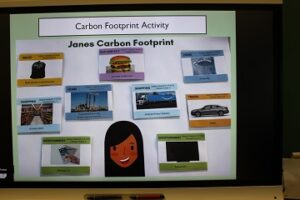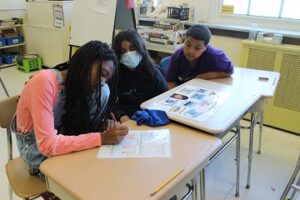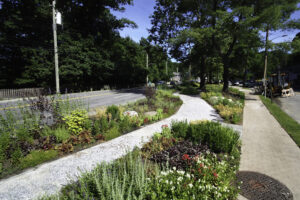 It’s simple! To reduce your carbon footprint, which is the amount of CO2 released into the atmosphere because of your personal energy use, one can draw upon a number of different ways to be more environmentally friendly without having a major trade-off in lifestyle. That’s what Washington Irving 5th and 6th graders learned when Dana and Caryn from the Greenburgh Nature Center visited last week as part of the on-going relationship between Tarrytown Schools and the Nature Center.
It’s simple! To reduce your carbon footprint, which is the amount of CO2 released into the atmosphere because of your personal energy use, one can draw upon a number of different ways to be more environmentally friendly without having a major trade-off in lifestyle. That’s what Washington Irving 5th and 6th graders learned when Dana and Caryn from the Greenburgh Nature Center visited last week as part of the on-going relationship between Tarrytown Schools and the Nature Center.
To begin, the children discussed all of the components that create a person’s carbon footprint, and then talked about potential strategies to help reduce it. Daily activities like transportation, energy use in your home, and the type of food you eat all contribute. The students learned that by making small changes, such as recycling and riding a bike more often, that even they can start to make a big difference.
The children broke into small groups, and using a placemat as a guide, they discussed ways that “Jane,” a fictitious friend, could use less energy daily. Examining how Jane eats, travels, enjoys entertainment and recycles, students assessed her carbon footprint. They were also taught to look at Jane’s lifestyle and what those points equate to. For example, driving a car everywhere leaves a high carbon footprint but may be high in lifestyle points due to the convenience and luxury it affords. Students discussed that taking a bus or riding a bike periodically could reduce one’s carbon footprint but that decision has to be considered in terms of their lifestyle. This lesson demonstrated that being more environmentally friendly may require trade-offs and the people can consider the decisions and trade-offs they are willing to make to lower their personal carbon footprint.
 In Ms. Spagnoli’s class, Caryn from the Greenburgh Nature Center explained that to be successful in reducing your carbon footprint “you need to do so in a way that fits with your lifestyle, so that it works for you” otherwise it’s hard to stick with it. As students weighed in, Maddie explained to her classmates that if ‘Jane’ could recycle more, she would generate less garbage. Plus for entertainment, Maddie said that Jane might consider spending more time outside.
In Ms. Spagnoli’s class, Caryn from the Greenburgh Nature Center explained that to be successful in reducing your carbon footprint “you need to do so in a way that fits with your lifestyle, so that it works for you” otherwise it’s hard to stick with it. As students weighed in, Maddie explained to her classmates that if ‘Jane’ could recycle more, she would generate less garbage. Plus for entertainment, Maddie said that Jane might consider spending more time outside.
In choosing trade-offs, many of the students in both classes decided that Jane could embrace a vegetarian diet because eating less meat reduces greenhouse gasses. And, to get places Jane could ride her bicycle more. Dana from the Nature Center explained to Ms Dorn’s class that “there are no wrong choices, but we do have to make choices.” By doing this we can live on a healthier planet.






